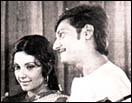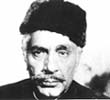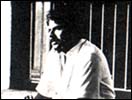
Commentary/Rajeev Srinivasan
The Magic Lantern

|
Loveable comedy: Choti Si Baat. Click here for bigger pic!
|
Once again it is time to pick my personal, idiosyncratic, whimsical favorites of the last fifty years. My own peculiar tastes come to the fore: I prefer the so-called art film to the commercial, running-around-trees Bollywood genre, and I have kept away from the latter as much as possible. Naturally, this has led me to the New Wave and directors like Shyam Benegal, Adoor Gopalakrishnan, Mani Kaul, Govind Nihalani, Girish Kasaravalli, Basu Bhattacharya, G. Aravindan, Shaji N Karun, and Mrinal Sen.
I also believe there is a middle of the road Indian film genre -- neither crassly commercial nor austerely artistic -- that can appeal to both types of audiences. Early examples included those lovable comedies Chitchor (Thief of Hearts) and Choti Si Baat (A Little Something), which I thoroughly enjoyed; or more recently, Mani Ratnam's superb work that has 'crossover' appeal.
Furthermore, I can only follow Hindi films adequately with sub-titles -- the Hindi I learned in school is a chaste literary Hindi with practically no words of Persian origin --and so I have avoided most of the popular films, such as Sholay and Hum Aapke Hain Kaun. I am vaguely aware they exist, but that's about all. Similarly with Malayalam films too, I have avoided the many banal films that are produced every year. Who exactly goes to see these, umm... things?
Without further ado, then, my list:

|
Masterpiece: Charulata. Click here for bigger pic!
|
Charulata, Satyajit Ray, Bengali.
There is no doubt that this film is one of the greatest masterpieces of world cinema --something of jewel-like beauty like a Mughal or Rajasthani miniature painting, focused intensely on one person. The opening and closing sequences themselves are among the most impressive in all cinema.
My top ten films
Battleship Potemkin, Sergei Eisenstein, Soviet Union.
Z, Costa-Gavras, France.
2001: A Space Odyssey, Stanley Kubrick, USA.
Charulata, Satyajit Ray, India.
Brazil, Terry Gilliam, UK.
Kagemusha, Akira Kurosawa, Japan.
Amarcord, Federico Fellini, Italy.
The 400 Blows, Francois Truffaut, France.
Dr Strangelove, Stanley Kubrick, USA.
Piravi, Shaji N Karun, India.
|
The opening scene -- the beautiful Charulata follows the outside world through the blinds, using her opera glasses -- speaks volumes about the gilded cage she inhabits. The closing scene where Charulata and her husband's hands reach out to each other, but do not quite touch, that is another masterful sequence that speaks wordlessly about guilt and forgiveness. I am reminded of some of the most imaginative sequences in the history of cinema, for example, Sergei Eisenstein's Odessa Ballet montage in Battleship Potemkin, arguably the best film of all time.
If anyone thinks Ray only made films about the rural poor of Bengal, Charulata is highly recommended to disabuse you of that notion.
Apu Trilogy, Satyajit Ray, Bengali.

|
Lyrical: Apur Sansar. Click here for bigger pic!
|
What can one say, the master at his best. In terms of sheer lyrical beauty, the trilogy of Pather Panchali, Aparajito and Apur Sansar is seldom equalled in world cinema. In particular, the extraordinarily tender scenes of marital bliss -- short-lived, alas -- between Sharmila Tagore and Soumitra Chatterjee in Apur Sansar are perhaps the most natural and lovely such scenes I have ever seen in Indian cinema.
Madhumati, Bimal Roy, Hindi.

|
Crossover appeal: Madhumati. Click here for bigger pic!
|
One of those early Hindi films that managed to have crossover appeal; despite the fact that it is a fairly pedestrian love story, the songs are so wonderful that even I, a non-Hindi speaker, cannot get them out of my mind: Aa ja re pardesi (Come, O stranger), Dil dhatak dhatak ke kehen rahan hai aa bhi ja (My heart beats an invitation to you) etc. remind me again of how Hindi film music, with all its usual crassness, sometimes reaches the level of sublime art.
I can't remember the hero or heroine, except that she was lovely and looked suitably ethereal, yet I will never forget the songs, nor the fact that I was deeply moved when I saw the film years ago. I love ghost stories, two of my favorite films are the Malayalam Bhargavi Nilayam (with the haunting Thamasam enthe varuvan (Why, my beloved, are you late?) and Yakshi, not quite a ghost story, but almost, either a tale of a man's descent into paranoia or his encounter with a seductive, destructive naiad (a yakshi), depending on your point of view.
Ankur (The Seedling), Shyam Benegal, Hindi.

|
Film-as-social-conscience: Ankur. Click here for bigger pic!
|
I have always been a fan of Shabana Azmi's acting (and not of her politics), and I found this debut film of hers (I think) which propelled her -- and in similar roles, Smita Patil -- to stardom very interesting, because it lays bare the exploitative feudal system in Andhra Pradesh. This film marked Benegal's appearance on the film scene, and is one of the highlights of the New Wave for me.
Film-as-social-conscience, later repeated in Chomana Dudi, Oka Oorie Katha, Ardh Satya, Aakrosh, and so forth, forms the core of the serious cinema in India.
Garam Hawa, M S Sathyu, Hindi.

|
Of Partition and divided loyalties: Garam Hawa. Click here for bigger pic!
|
One of the best films about Partition, this was also Balraj Sahni's last role: he portrayed a Muslim man torn between the siren song of Pakistan and his love for the India he grew up in. Like Manto's tales, this film haunts you with the futility of the Holocaust that our nation went through. In passing, it also reminds me of the strange fact that Karnataka has produced several film-makers in Hindi -- Shyam Benegal, M S Sathyu, Girish Karnad -- unlike the rest of the southern states.
Piravi (The Birth), Shaji, Malayalam.
This is one of the most beautiful and tragic of Indian films. Shaji, a brilliant cinematographer, made his directorial debut adapting the real-life story of an engineering student, Rajan, one of those tortured and murdered during the Emergency. Shaji has turned it into a heart-breaking meditation of the unspoken bonds between father and son.
Octogenarian Premji brings hauntingly to life the old man who searches for the boy whom he fathered in his old age. It is a universal story of political prisoners, the 'disappeared' ones, from Argentina to Chile to Palestine to Tibet, and of those they have left behind. At the same time, it is an intimately personal tribute to the beauty of the Kerala landscape.
Anantaram (Monologue), Adoor Gopalakrishnan, Malayalam.

|
On truth and perception: Anantaram. Click here for bigger pic!
|
The two film-makers who took on Satyajit Ray's mantle as the greatest film-makers in India are, in my opinion, Adoor and G Aravindan. And their styles could not be more different. Adoor, like Ray, is an extraordinarily accomplished master of the medium, and his films are perfect, gem-like: he is clearly incapable of sounding a false note. Aravindan, on the other hand, took risks and made flawed masterpieces, sometimes his films soar like eagles, and other times they are leaden turkeys.
Anantaram is my favorite Adoor film, because it explores the fine line between truth and perception, in the persona of a disturbed young man, Ajayan. He tells his story; Rashomon-like, he then retells it from a different perspective. And we realize that both these are valid interpretations of some objective 'truth'. In fact, is there anything but subjective realities?
Chidambaram, G Aravindan, Malayalam.
Aravindan's exploration of guilt, crime and punishment, set in the high ranges between Kerala and Tamil Nadu is a landmark film. Brilliant acting by Gopi and Smita Patil turns this story of adulterous love, and the disastrous consequences thereof, into something that transcends the usual genre.
The guilty Gopi flees, believing Smita has been hacked to death by her enraged husband; his journey of self-excoriation ends at the temple town of Chidambaram where he encounters, bearing the scars of the sickle, the woman he had once loved. But then, is it in fact the same woman, or someone else? The interior monologue of Gopi, his punishment of himself and finally, perhaps, his redemption, make for a fascinating tale.
Uttarayanam (Solstice), G Aravindan, Malayalam.

|
Sensitive political message: Vaastuhara. Click here for bigger pic!
|
Aravindan's debut film, Uttarayanam, as well as his last one (before his untimely death), Vaastuhara (The Dispossessed), are particular favourites of mine because of the sensitively-handled political messages. Uttarayanam is a lament for a 'lost generation', Midnight's Children, who watch in impotent rage the perversion of the ideals of the Freedom Struggle as unscrupulous small men gain power. As in Satyajit Ray's under-rated Calcutta Trilogy, the angst of the urban middle-classes leads them to acts of desperation: here, the sensitive young man decides to become -- a revolutionary or a monk; the ending is ambiguous.
Roja, Mani Ratnam, Tamil.
There are three aspects to this film that make it one of my favourites: the explicit and uncompromising nationalism, the spectacular music, and the judicious choice of elements of both popular and art cinema. The story of the young Tamil man abducted by Kashmiri separatists and held to ransom and his awakening of his love for his country, as well as the plight of his simple villager bride, make for a satisfying film. A R Rehman's brilliant songs, Chinna chinna asai (A tiny little wish), Tamizha Tamizha are deliciously addictive.
Tell us what you think of this column
|





